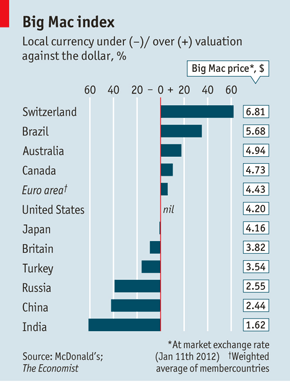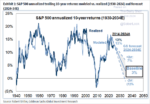The Economist‘s Big Mac index is based on the theory of purchasing-power parity: that, in the long run, exchange rates should adjust to equal the price of a basket of goods and services in different countries. Our basket consists of one McDonald’s Big Mac, and we’ve compared it with the average price in America, $4.20. According to our burgernomics, the Swiss franc is 62% overvalued: the exchange rate that would equalise the price of a Swiss Big Mac with an American one is 1.55 francs to the dollar; the actual exchange rate is only 0.96. The cheapest burger is found in India, where it costs just $1.62. Big Macs aren’t sold in India, so we’ve taken the price of a Maharaja Mac, made with chicken instead of beef.

The following table compares the Big Mac and the Starbucks Tall Latte, another frequently issued index, among different countries.
Country Starbucks tall latte index McDonald's Big Mac Index
Australia -4 -17
United Kingdom +17 +23
Canada -16 -16
China -1 -56
Eurozone +33 +24
Hong Kong +15 -45
Japan +13 -12
Malaysia -25 -53
Mexico -15 -21
New Zealand -12 -4
Singapore +2 -31
South Korea +6 0
Switzerland +62 +82
Taiwan -5 -21
Thailand -31 -46
Turkey +6 +5
Source Wikiwealth, summer 2012
Critique:
These indexes include both tradable and non-tradable goods. Non-tradable goods must be more expensive in richer countries, because they are not exposed to global competition. Therefore, the difference between poorer and richer countries is accentuated.
They use a single product as comparison basis for all countries. A non-tradable good, especially locally produced food is not useful, given that quotas or taxes might exist.
Tariffs: Certain countries like Switzerland use import quotas and taxes for meat or milk to protect local farmers. These measurements do not make sense as food prices do not say nearly anything about the competitiveness of an economy.
Portion size: Food indices do not count for portion sizes. If you often travel then you will realize that portions in the U.S. or Northern Europe are bigger than in Asia or Southern countries, Switzerland, France or even Russia. Hence Americans might eat two Big Macs when a Swiss or an Asian eat only one. But higher quantities consumed reduce the costs per quantity, but it this case, it falsifies the food index.
See more for















